Free-time Residences 2013
Varsinais-Suomi was the region with the highest number of free-time residences in 2013
According to Statistics Finland, there were 499,000 free-time residences in Finland at the end of 2013. The order of municipalities with the highest number of free-time residences remained unchanged in 2013. Measured by the number of free-time residences, Mikkeli had the highest number of free-time residences.
Varsinais-Suomi was the region with the highest number of free-time residences, i.e. 49,000. Etelä-Savo and Pirkanmaa also had more than 45,000 free-time residences. The numbers of free-time residences were lowest in the regions of Central Ostrobothnia (3,900) and Åland (6,200).
Figure 1. Free-time residences by region 2013
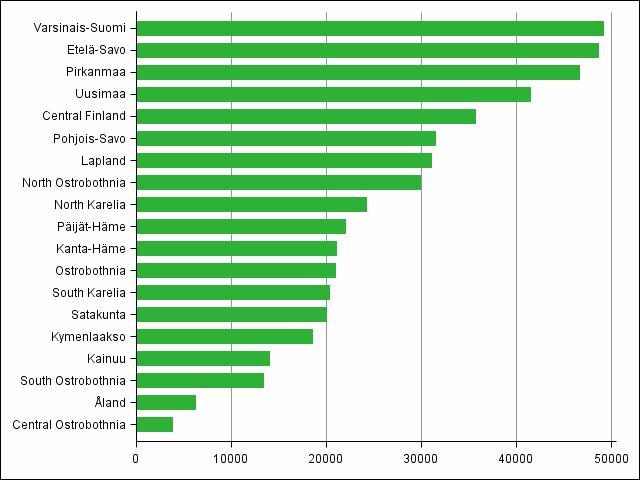
The density of free-time residences in the municipality can also be described by comparing their number with that of permanently occupied dwellings. Then the municipalities richest in free-time residences were places that had a relatively low number of population and a high number of free-time residences. At the end of 2013, altogether 59 municipalities had more free-time residences than permanently occupied dwellings. Such municipalities were Parainen, Mäntyharju, Kemiönsaari and Pälkäne. As the number of permanent residents decreases, the number of free-time residences may become emphasised in ever more municipalities. From 2000 onwards, the number of municipalities with a majority of free-time residences has increased approximately by ten, when the situation is viewed with the present division of municipalities of 2014.
Figure 2. Municipalities with more free-time residences than occupied dwellings in 2013 (municipalities with the highest number of free-time residences)
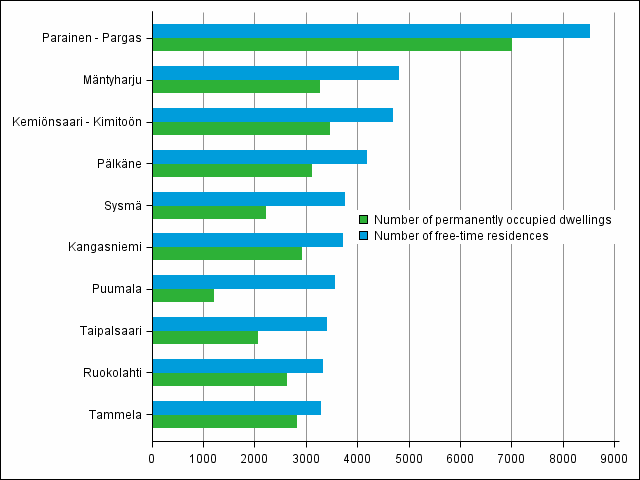
Stock of free-time residences grew fastest in the 1980s
There were 498,700 free-time residences in Finland at the end of 2013. The number increased by 2,500 from the previous year. The stock of free-time residences does not grow direct due to newbuilding because some free-time residences area converted into permanent dwellings or their active use is discontinued.
The number of free-time residences grew fastest in the 1980s. In 1990, there were 368,000 free-time residences, which was 46 per cent more than in 1980. From 1970 to 1980, the increase was 75,600, or 43 per cent.
Figure 3. Number of free-time residences 1970–2013
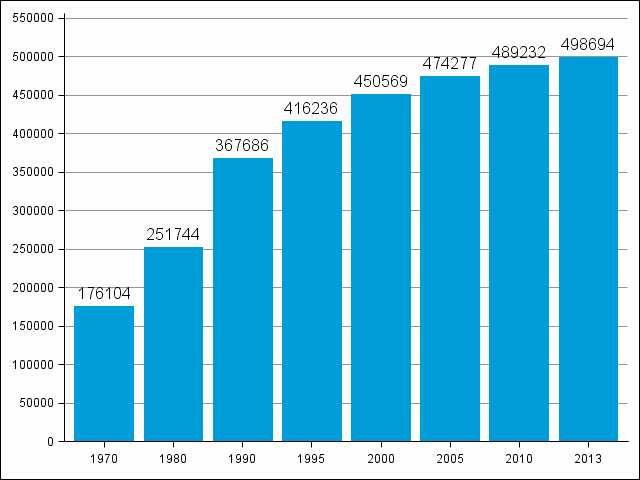
The pace of construction of free-time residences has been slowing down steadily since the early years of the 1990s. Whereas roughly 8,000 free-time residences were built every year in the early 1990s, in recent years the number has been half of this. Through the 1990s, the stock of free-time residences grew by around 20 per cent. This is clearly by less than in the 1970s and 1980s, when the stock increased by over 40 per cent per decade.
About 3,000 new free-time residences completed per year
Over 4,000 new free-time residential buildings have been completed per year in the 2000s. In the 2010s the number of new free-time residential buildings has decreased under 4,000 per year. For example, 3,300 new free-time residential buildings were completed in 2013 (according to statistics of buildingstock).
During 2013, the highest numbers of new free-time residences were built in Etelä-Savo and Lapland. By municipality, the highest numbers of new free-time residences were built in Kuusamo, Vöyri, Savonlinna and Puumala: over 50 in the year in each. In absolute numbers, the construction of free-time residences decreased further.Figure 4. Regions with highest numbers of new free-time residences built in 2013
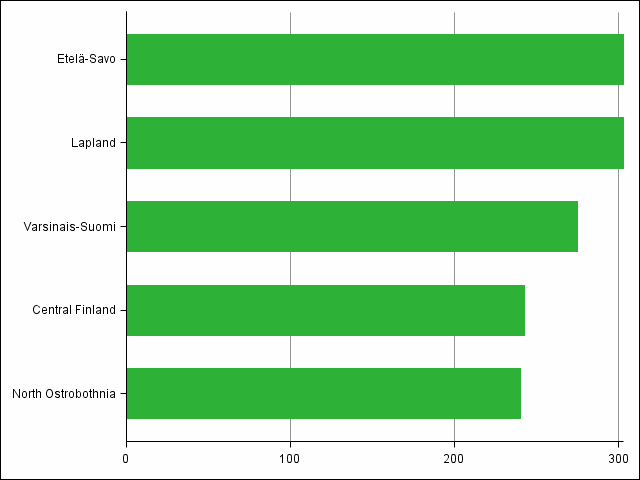
Building of free-time residences liveliest in Lapland, Etelä-Savo and Varsinais-Suomi
In 2013 the building of free-time residences has been liveliest in Etelä-Savo and Lapland. In the 2000s, the highest numbers of free-time residential buildings have been completed in general in Lapland, Etelä-Savo and Varsinais-Suomi where their number has approximately 400 per year.
Since 1990 the stock of free-time residences has grown most in Etelä-Savo, where it has increased by 13,600. The stock has changed least in Central Ostrobothnia and Åland where the number of free-time residences has increased by nearly 2,000 since 1990.
Summer residence densest in Kustavi and Kaskinen
Free-time residences are densest in the municipality of Kustavi and Kaskinen with average 15–18 free-time residences per square kilometre of land. In six municipalities there are more than ten free-time residences per square kilometre. In the whole country there are, on the average, 1.6 free-time residences per square kilometre. Varsinais-Suomi, Uusimaa, Päijät-Häme, Kanta-Häme and Åland have more than four free-time residences per square kilometre. In North and Central Ostrobothnia, and Kainuu and Lapland there is average less than one free-time residence per square kilometre. In proportion to the land area, Kauniainen, Savukoski, Utsjoki, and Enontekiö have the lowest number of free-time residences.
Figure 5. Free-time residences by municipalities in 2013
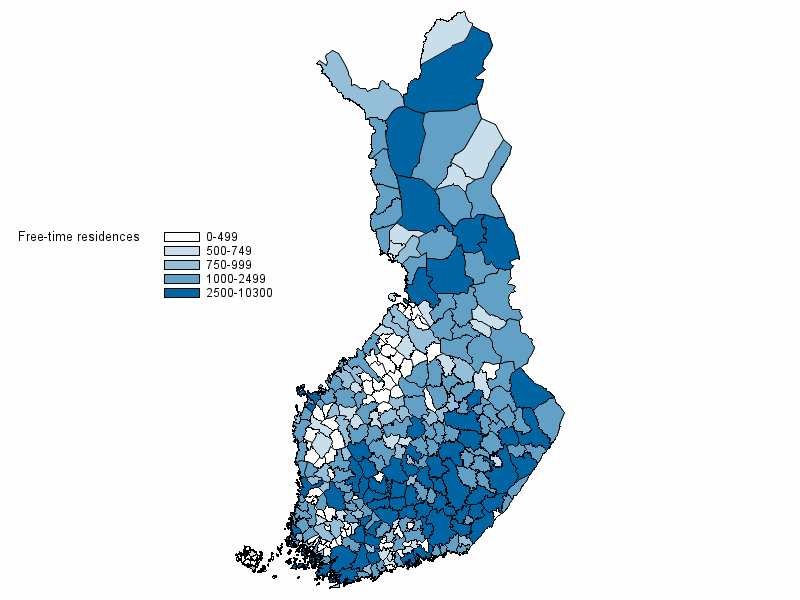
Avarage floor area of free-time residences 48 square metres
There are relatively large size differences between new and old free-time residences. The average floor area of the free-time residences built in 2000-2009 was 64 square metres. The median was 40 square metres. On the other hand, nearly one free-time residence in four had a floor area of 60 square metres or more.
Table 1. Free-time residences by floor area in 2013
| Floor area, m2 | Number of free-time residences | % |
| Free-time residences, total | 498 694 | 100,0 |
| – 19 | 45 911 | 9,2 |
| 20 – 39 | 181 055 | 36,3 |
| 40 – 59 | 134 198 | 26,9 |
| 60 – 79 | 62 243 | 12,5 |
| 80 – 99 | 28 613 | 5,7 |
| 100 – | 27 840 | 5,6 |
| Unknown | 18 834 | 3,8 |
| Average floor space | 48 | .. |
| Median floor space | 40 | .. |
Almost 800 000 Finns belong to a household-dwelling unit with a free-time residence
Of all free-time residences, 405,000 were owned by private persons, while 93,000 were owned by companies, communities and deceased’s estates, or by foreigners. In all, almost 800,000 persons belonged to a household-dwelling unit which owns a free-time residence. Free-time residences are generally located near the place of permanent residence. Two-thirds of free-time residence owners had a free-time residence in their region of residence. One-third of free-time residence owners had a free-time residence in their municipality of domicile. Summer residents more than double the population of many municipalities.
Average age of a free-time residence owners is 61 years
The average age of owners of new free-time residences completed in 2013 was 54 years. The average age of all free-time residence owners was 61. Of all free-time residence owners, 24,000 or just six per cent were aged under 40. Over 40 per cent of all free-time residences were owned by a household-dwelling unit of two adults and only 14 per cent by households with children aged under 18.
Source: Buildings and Free-time Residences, Statistics Finland
Inquiries: Topias Pyykkönen 09 1734 2628 ( 9.6.2014 => 029 551 2628 ), Marja Hermiö 09 1734 3211, Arja Tiihonen 09 1734 3272, asuminen@stat.fi
Director in charge: Harala Riitta
Updated 23.5.2014
Official Statistics of Finland (OSF):
Buildings and free-time residences [e-publication].
ISSN=1798-6796. 2013,
Free-time Residences 2013
. Helsinki: Statistics Finland [referred: 26.12.2025].
Access method: http://stat.fi/til/rakke/2013/rakke_2013_2014-05-23_kat_001_en.html

